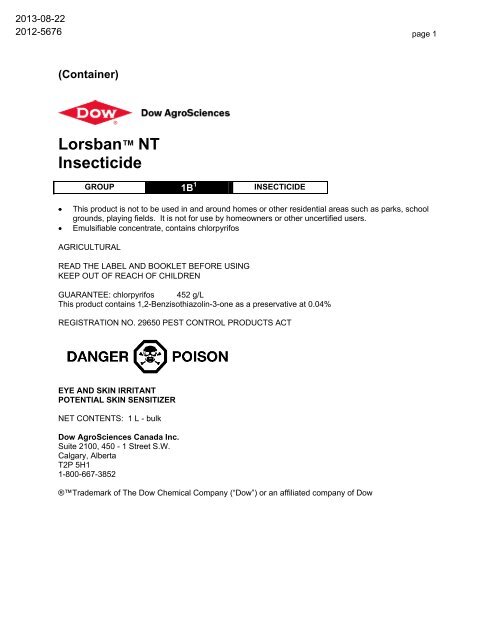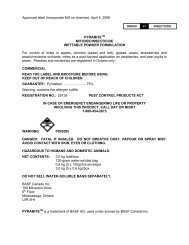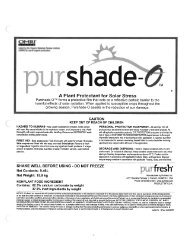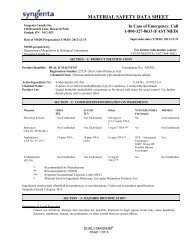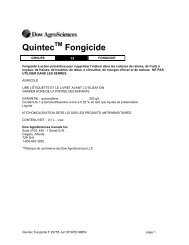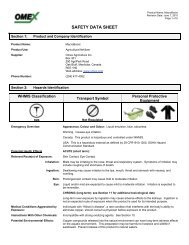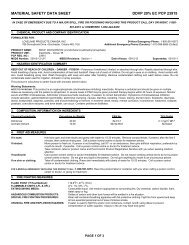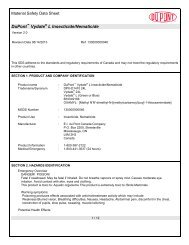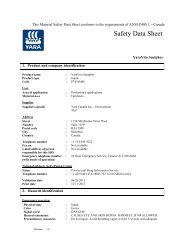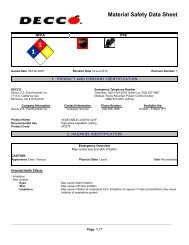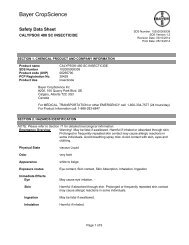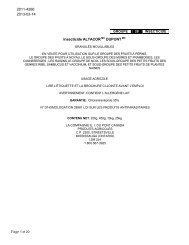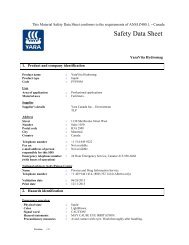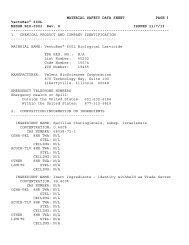Lorsban NT label english.pdf - Bartlett.ca
Lorsban NT label english.pdf - Bartlett.ca
Lorsban NT label english.pdf - Bartlett.ca
You also want an ePaper? Increase the reach of your titles
YUMPU automatically turns print PDFs into web optimized ePapers that Google loves.
2013-08-22<br />
2012-5676<br />
page 1<br />
(Container)<br />
<strong>Lorsban</strong> <strong>NT</strong><br />
Insecticide<br />
GROUP 1B 1 INSECTICIDE<br />
<br />
<br />
This product is not to be used in and around homes or other residential areas such as parks, school<br />
grounds, playing fields. It is not for use by homeowners or other uncertified users.<br />
Emulsifiable concentrate, contains chlorpyrifos<br />
AGRICULTURAL<br />
READ THE LABEL AND BOOKLET BEFORE USING<br />
KEEP OUT OF REACH OF CHILDREN<br />
GUARA<strong>NT</strong>EE: chlorpyrifos 452 g/L<br />
This product contains 1,2-Benzisothiazolin-3-one as a preservative at 0.04%<br />
REGISTRATION NO. 29650 PEST CO<strong>NT</strong>ROL PRODUCTS ACT<br />
EYE AND SKIN IRRITA<strong>NT</strong><br />
POTE<strong>NT</strong>IAL SKIN SENSITIZER<br />
NET CO<strong>NT</strong>E<strong>NT</strong>S: 1 L - bulk<br />
Dow AgroSciences Canada Inc.<br />
Suite 2100, 450 - 1 Street S.W.<br />
Calgary, Alberta<br />
T2P 5H1<br />
1-800-667-3852<br />
®Trademark of The Dow Chemi<strong>ca</strong>l Company (“Dow”) or an affiliated company of Dow
page 2<br />
PRECAUTIONS<br />
FATAL OR POISONOUS IF SWALLOWED<br />
HARMFUL IF ABSORBED THROUGH SKIN<br />
CAUSES EYE AND SKIN IRRITATION<br />
POTE<strong>NT</strong>IAL SKIN SENSITIZER<br />
KEEP OUT OF REACH OF CHILDREN<br />
Do not get in eyes, on skin or on clothing. Avoid breathing vapour or spray mist. Handle only with<br />
adequate ventilation. Wear protective clothing, impervious gloves and chemi<strong>ca</strong>l worker’s goggles when<br />
handling. Wash thoroughly with soap and water after handling and before eating or smoking. Immediately<br />
remove contaminated clothing and wash before reuse. Destroy contaminated leather articles including<br />
shoes. Do not apply this product in such a manner as to directly or through drift expose workers or other<br />
persons.<br />
PRECAUTIONS FOR MIXERS/LOADERS<br />
For containers more than 10 L:<br />
Mixers/loaders must use a closed mechani<strong>ca</strong>l transfer loading system. Mixers/loaders must wear:<br />
• coveralls over a long-sleeved shirt and long pants<br />
• chemi<strong>ca</strong>l-resistant gloves<br />
• an air-purifying respirator with an -R or -P series filter<br />
• shoes and socks<br />
For containers holding 10 L or less:<br />
Mixers/loaders must wear:<br />
• coveralls over a long-sleeved shirt and long pants<br />
• chemi<strong>ca</strong>l-resistant gloves<br />
• a chemi<strong>ca</strong>l-resistant apron<br />
• chemi<strong>ca</strong>l-resistant footwear plus socks<br />
• an air-purifying respirator equipped with an -R or -P series filter<br />
PRECAUTIONS FOR APPLICATORS<br />
Do not apply with high-pressure handwand equipment.<br />
Appli<strong>ca</strong>tors using ground appli<strong>ca</strong>tion equipment with a closed <strong>ca</strong>b must wear:<br />
• a long-sleeved shirt and long pants<br />
• chemi<strong>ca</strong>l-resistant gloves when leaving <strong>ca</strong>b for clean up and repair (gloves must be removed when<br />
re-entering the <strong>ca</strong>b)<br />
• socks and shoes<br />
Appli<strong>ca</strong>tors using ground appli<strong>ca</strong>tion equipment with an open <strong>ca</strong>b must wear:<br />
• coveralls over a long-sleeved shirt and long pants<br />
• chemi<strong>ca</strong>l-resistant gloves<br />
• socks and shoes<br />
Appli<strong>ca</strong>tors using aerial appli<strong>ca</strong>tion equipment must use enclosed cockpits and must wear:<br />
• a long-sleeved shirt and long pants<br />
• socks and shoes
page 3<br />
Appli<strong>ca</strong>tors using handheld equipment must wear:<br />
• a long-sleeved shirt and long pants<br />
• chemi<strong>ca</strong>l-resistant coveralls and head protection (if spray is upwardly directed)<br />
• chemi<strong>ca</strong>l-resistant footwear and socks<br />
• chemi<strong>ca</strong>l-resistant gloves<br />
• an air purifying respirator with an -R or -P series filter<br />
If this pest control product is to be used on a commodity that may be exported to the U.S. and you require<br />
information on acceptable residue levels in the U.S., visit CropLife Canada’s web site at www.croplife.<strong>ca</strong>.<br />
PHYSICAL OR CHEMICAL HAZARDS<br />
COMBUSTIBLE. Do not use or store near heat or open flame. Do not cut or weld container.<br />
FIRST AID<br />
Take container, <strong>label</strong> or product name and Pest Control Product Registration Number with you<br />
when seeking medi<strong>ca</strong>l attention.<br />
If swallowed: Call a poison control centre or doctor immediately for treatment advice. Do not<br />
induce vomiting unless told to do so by a poison control centre or doctor. Do not give any liquid to the<br />
person. Do not give anything by mouth to an unconscious person.<br />
If on skin or clothing: Take off contaminated clothing. Rinse skin immediately with plenty of water for<br />
15-20 minutes. Call a poison control centre or doctor for treatment advice.<br />
If inhaled: Move person to fresh air. If person is not breathing, <strong>ca</strong>ll 911 or an ambulance, then give<br />
artificial respiration, preferably by mouth-to-mouth, if possible. Call a poison control centre or doctor for<br />
further treatment advice.<br />
If in eyes: Hold eye open and rinse slowly and gently with water for 15-20 minutes. Remove contact<br />
lenses, if present, after the first 5 minutes, then continue rinsing eye. Call a poison control centre or<br />
doctor for treatment advice.<br />
TOXICOLOGICAL INFORMATION<br />
Chlorpyrifos is an organophosphate that is a cholinesterase inhibitor. Typi<strong>ca</strong>l symptoms of overexposure<br />
to cholinesterase inhibitors include headache, nausea, dizziness, sweating, salivation, runny nose and<br />
eyes. This may progress to muscle twitching, weakness, tremors, incoordination, vomiting, abdominal<br />
cramps and diarrhea in more serious poisonings. A life-threatening poisoning is signified by loss of<br />
consciousness, incontinence, convulsions and respiratory depression with a secondary <strong>ca</strong>rdiovascular<br />
component. Treat symptomati<strong>ca</strong>lly. If exposed, plasma and red blood cell cholinesterase tests may<br />
indi<strong>ca</strong>te degree of exposure (baseline data are useful). Atropine, only by injection, is the preferable<br />
antidote. Oximes, such as pralidoxime chloride, may be therapeutic if used early; however, use only in<br />
conjunction with atropine. In <strong>ca</strong>ses of severe acute poisoning, use antidotes immediately after<br />
establishing an open airway and respiration. With oral exposure, the decision of whether to induce<br />
vomiting or not should be made by an attending physician.<br />
NOTE: Product contains a petroleum distillate solvent. Vomiting may <strong>ca</strong>use aspiration pneumonia.<br />
AGRICULTURAL CHEMICAL<br />
Do not ship or store with food, feeds, drugs or clothing.<br />
ENVIRONME<strong>NT</strong>AL HAZARDS<br />
<strong>Lorsban</strong> <strong>NT</strong> Insecticide is toxic to birds and wildlife and extremely toxic to fish and aquatic organisms. Do<br />
not apply directly to water. Drift and run-off from treated areas may be hazardous to aquatic organisms in<br />
adjacent aquatic sites. Spilled material should be soaked up with absorbent material and disposed of in<br />
an approved manner. Do not contaminate water by cleaning of equipment or disposal of waste. This<br />
product is highly toxic to bees exposed to direct treatment or residues on blooming crops or weeds. Avoid<br />
use when bees are actively foraging. Cereals grown for cover crop treated with <strong>Lorsban</strong> <strong>NT</strong> insecticide<br />
should not be harvested for human or animal consumption if treated within 60 days of harvest.
page 4<br />
This product contains a petroleum distillate which is moderately to highly toxic to aquatic organisms.<br />
Avoid contamination of aquatic systems during appli<strong>ca</strong>tion. Do not contaminate these systems through<br />
direct appli<strong>ca</strong>tion, disposal of waste or cleaning equipment.<br />
TOXIC to birds. Any spilled or exposed granules must be incorporated into the soil or otherwise<br />
cleaned-up from the soil surface.<br />
TOXIC to wild mammals. Any spilled or exposed granules must be incorporated into the soil or<br />
otherwise cleaned-up from the soil surface.<br />
TOXIC to bees exposed to direct treatment, drift, or residues on blooming plants. Do not use on<br />
flowering crops or weeds.<br />
TOXIC to certain beneficial insects. Minimize spray drift to reduce harmful effects on beneficial insects<br />
in habitats next to the appli<strong>ca</strong>tion site such as hedgerows and woodland<br />
DO NOT apply this product or allow it to drift to flowering crops or weeds if bees are visiting the<br />
treatment area. Appli<strong>ca</strong>tors should inform lo<strong>ca</strong>l bee keepers prior to appli<strong>ca</strong>tion if hives are in adjacent<br />
fields. Minimize spray drift to reduce harmful effects on bees in habitats close to the appli<strong>ca</strong>tion site.<br />
To reduce runoff from treated areas into aquatic habitats, consider the characteristics and conditions<br />
of the site before treatment. Site characteristics and conditions that may lead to runoff include, but are<br />
not limited to, heavy rainfall, moderate to steep slope, bare soil, poorly draining soil (e.g., soils that are<br />
compacted or fine textured such as clay).<br />
Avoid appli<strong>ca</strong>tion of this product when heavy rain is fore<strong>ca</strong>st.<br />
Contamination of aquatic areas as a result of runoff may be reduced by including a vegetative strip<br />
(buffer zone) between the treated area and the edge of the water body.<br />
STORAGE<br />
Do not contaminate water, food or feed by storage or disposal of wastes.<br />
DISPOSAL<br />
Recyclable Containers:<br />
Do not reuse this container for any purpose. This is a recyclable container, and is to be disposed of at a<br />
container collection site. Contact your lo<strong>ca</strong>l distributor/dealer or municipality for the lo<strong>ca</strong>tion of the<br />
nearest collection site. Before taking the container to the collection site:<br />
1. Triple- or pressure-rinse the empty container. Add the rinsings to the spray mixture in the tank.<br />
2. Make the empty, rinsed container unsuitable for further use.<br />
If there is no container collection site in your area, dispose of the container in accordance with provincial<br />
requirements.<br />
Returnable Containers:<br />
Do not reuse this container for any purpose. For disposal, this empty container may be returned to the<br />
point of purchase (distributor/dealer).<br />
For information on disposal of unused, unwanted product, contact the manufacturer or the provincial<br />
regulatory agency. Contact the manufacturer and the provincial regulatory agency in <strong>ca</strong>se of a spill, and<br />
for clean-up of spills.<br />
NOTICE TO USER: This pest control product is to be used only in accordance with the directions on the<br />
<strong>label</strong>. It is an offence under the Pest Control Products Act to use this product in a way that is inconsistent<br />
with the directions on the <strong>label</strong>. The user assumes the risk to persons or property that arises from any<br />
such use of this product.
page 5<br />
(Booklet)<br />
<strong>Lorsban</strong> <strong>NT</strong><br />
Insecticide<br />
GROUP 1B 1 INSECTICIDE<br />
<br />
<br />
This product is not to be used in and around homes or other residential areas such as parks, school<br />
grounds, playing fields. It is not for use by homeowners or other uncertified users.<br />
Emulsifiable concentrate, contains chlorpyrifos<br />
AGRICULTURAL<br />
READ THE LABEL AND BOOKLET BEFORE USING<br />
KEEP OUT OF REACH OF CHILDREN<br />
GUARA<strong>NT</strong>EE: chlorpyrifos 452 g/L<br />
This product contains 1,2-Benzisothiazolin-3-one as a preservative at 0.04%<br />
REGISTRATION NO. 29650 PEST CO<strong>NT</strong>ROL PRODUCTS ACT<br />
EYE AND SKIN IRRITA<strong>NT</strong><br />
POTE<strong>NT</strong>IAL SKIN SENSITIZER<br />
NET CO<strong>NT</strong>E<strong>NT</strong>S: 1 L - bulk<br />
Dow AgroSciences Canada Inc.<br />
Suite 2100, 450 - 1 Street S.W.<br />
Calgary, Alberta<br />
T2P 5H1<br />
1-800-667-3852<br />
®Trademark of The Dow Chemi<strong>ca</strong>l Company (“Dow”) or an affiliated company of Dow
page 6<br />
PRECAUTIONS<br />
FATAL OR POISONOUS IF SWALLOWED<br />
HARMFUL IF ABSORBED THROUGH SKIN<br />
CAUSES EYE AND SKIN IRRITATION<br />
POTE<strong>NT</strong>IAL SKIN SENSITIZER<br />
KEEP OUT OF REACH OF CHILDREN<br />
Do not get in eyes, on skin or on clothing. Avoid breathing vapour or spray mist. Handle only with<br />
adequate ventilation. Wear protective clothing, impervious gloves and chemi<strong>ca</strong>l worker’s goggles when<br />
handling. Wash thoroughly with soap and water after handling and before eating or smoking. Immediately<br />
remove contaminated clothing and wash before reuse. Destroy contaminated leather articles including<br />
shoes. Do not apply this product in such a manner as to directly or through drift expose workers or other<br />
persons.<br />
PRECAUTIONS FOR MIXERS/LOADERS<br />
For containers more than 10 L:<br />
Mixers/loaders must use a closed mechani<strong>ca</strong>l transfer loading system. Mixers/loaders must wear:<br />
• coveralls over a long-sleeved shirt and long pants<br />
• chemi<strong>ca</strong>l-resistant gloves<br />
• an air-purifying respirator with an -R or -P series filter<br />
• shoes and socks<br />
For containers holding 10 L or less:<br />
Mixers/loaders must wear:<br />
• coveralls over a long-sleeved shirt and long pants<br />
• chemi<strong>ca</strong>l-resistant gloves<br />
• a chemi<strong>ca</strong>l-resistant apron<br />
• chemi<strong>ca</strong>l-resistant footwear plus socks<br />
• an air-purifying respirator equipped with an -R or -P series filter<br />
PRECAUTIONS FOR APPLICATORS<br />
Do not apply with high-pressure handwand equipment.<br />
Appli<strong>ca</strong>tors using ground appli<strong>ca</strong>tion equipment with a closed <strong>ca</strong>b must wear:<br />
• a long-sleeved shirt and long pants<br />
• chemi<strong>ca</strong>l-resistant gloves when leaving <strong>ca</strong>b for clean up and repair (gloves must be removed when<br />
re-entering the <strong>ca</strong>b)<br />
• socks and shoes<br />
Appli<strong>ca</strong>tors using ground appli<strong>ca</strong>tion equipment with an open <strong>ca</strong>b must wear:<br />
• coveralls over a long-sleeved shirt and long pants<br />
• chemi<strong>ca</strong>l-resistant gloves<br />
• socks and shoes<br />
Appli<strong>ca</strong>tors using aerial appli<strong>ca</strong>tion equipment must use enclosed cockpits and must wear:<br />
• a long-sleeved shirt and long pants<br />
• socks and shoes<br />
Appli<strong>ca</strong>tors using handheld equipment must wear:<br />
• a long-sleeved shirt and long pants<br />
• chemi<strong>ca</strong>l-resistant coveralls and head protection (if spray is upwardly directed)<br />
• chemi<strong>ca</strong>l-resistant footwear and socks<br />
• chemi<strong>ca</strong>l-resistant gloves<br />
• an air purifying respirator with an -R or -P series filter
page 7<br />
If this pest control product is to be used on a commodity that may be exported to the U.S. and you require<br />
information on acceptable residue levels in the U.S., visit CropLife Canada’s web site at www.croplife.<strong>ca</strong>.<br />
PHYSICAL OR CHEMICAL HAZARDS<br />
COMBUSTIBLE. Do not use or store near heat or open flame. Do not cut or weld container.<br />
FIRST AID<br />
Take container, <strong>label</strong> or product name and Pest Control Product Registration Number with you<br />
when seeking medi<strong>ca</strong>l attention.<br />
If swallowed: Call a poison control centre or doctor immediately for treatment advice. Do not induce<br />
vomiting unless told to do so by a poison control centre or doctor. Do not give any liquid to the person.<br />
Do not give anything by mouth to an unconscious person.<br />
If on skin or clothing: Take off contaminated clothing. Rinse skin immediately with plenty of water for<br />
15-20 minutes. Call a poison control centre or doctor for treatment advice.<br />
If inhaled: Move person to fresh air. If person is not breathing, <strong>ca</strong>ll 911 or an ambulance, then give<br />
artificial respiration, preferably by mouth-to-mouth, if possible. Call a poison control centre or doctor for<br />
further treatment advice.<br />
If in eyes: Hold eye open and rinse slowly and gently with water for 15-20 minutes. Remove contact<br />
lenses, if present, after the first 5 minutes, then continue rinsing eye. Call a poison control centre or<br />
doctor for treatment advice.<br />
TOXICOLOGICAL INFORMATION<br />
Chlorpyrifos is an organophosphate that is a cholinesterase inhibitor. Typi<strong>ca</strong>l symptoms of overexposure<br />
to cholinesterase inhibitors include headache, nausea, dizziness, sweating, salivation, runny nose and<br />
eyes. This may progress to muscle twitching, weakness, tremors, incoordination, vomiting, abdominal<br />
cramps and diarrhea in more serious poisonings. A life-threatening poisoning is signified by loss of<br />
consciousness, incontinence, convulsions and respiratory depression with a secondary <strong>ca</strong>rdiovascular<br />
component. Treat symptomati<strong>ca</strong>lly. If exposed, plasma and red blood cell cholinesterase tests may<br />
indi<strong>ca</strong>te degree of exposure (baseline data are useful). Atropine, only by injection, is the preferable<br />
antidote. Oximes, such as pralidoxime chloride, may be therapeutic if used early; however, use only in<br />
conjunction with atropine. In <strong>ca</strong>ses of severe acute poisoning, use antidotes immediately after<br />
establishing an open airway and respiration. With oral exposure, the decision of whether to induce<br />
vomiting or not should be made by an attending physician.<br />
NOTE: Product contains a petroleum distillate solvent. Vomiting may <strong>ca</strong>use aspiration pneumonia.<br />
AGRICULTURAL CHEMICAL<br />
Do not ship or store with food, feeds, drugs or clothing.<br />
ENVIRONME<strong>NT</strong>AL HAZARDS<br />
<strong>Lorsban</strong> <strong>NT</strong> Insecticide is toxic to birds and wildlife and extremely toxic to fish and aquatic organisms. Do<br />
not apply directly to water. Drift and run-off from treated areas may be hazardous to aquatic organisms in<br />
adjacent aquatic sites. Spilled material should be soaked up with absorbent material and disposed of in<br />
an approved manner. Do not contaminate water by cleaning of equipment or disposal of waste. This<br />
product is highly toxic to bees exposed to direct treatment or residues on blooming crops or weeds. Avoid<br />
use when bees are actively foraging. Cereals grown for cover crop treated with <strong>Lorsban</strong> <strong>NT</strong> insecticide<br />
should not be harvested for human or animal consumption if treated within 60 days of harvest.<br />
This product contains a petroleum distillate which is moderately to highly toxic to aquatic organisms.<br />
Avoid contamination of aquatic systems during appli<strong>ca</strong>tion. Do not contaminate these systems through<br />
direct appli<strong>ca</strong>tion, disposal of waste or cleaning equipment.
page 8<br />
TOXIC to birds. Any spilled or exposed granules must be incorporated into the soil or otherwise<br />
cleaned-up from the soil surface.<br />
TOXIC to wild mammals. Any spilled or exposed granules must be incorporated into the soil or<br />
otherwise cleaned-up from the soil surface.<br />
TOXIC to bees exposed to direct treatment, drift, or residues on blooming plants. Do not use on<br />
flowering crops or weeds.<br />
TOXIC to certain beneficial insects. Minimize spray drift to reduce harmful effects on beneficial insects<br />
in habitats next to the appli<strong>ca</strong>tion site such as hedgerows and woodland<br />
DO NOT apply this product or allow it to drift to flowering crops or weeds if bees are visiting the<br />
treatment area. Appli<strong>ca</strong>tors should inform lo<strong>ca</strong>l bee keepers prior to appli<strong>ca</strong>tion if hives are in adjacent<br />
fields. Minimize spray drift to reduce harmful effects on bees in habitats close to the appli<strong>ca</strong>tion site.<br />
To reduce runoff from treated areas into aquatic habitats, consider the characteristics and conditions<br />
of the site before treatment. Site characteristics and conditions that may lead to runoff include, but are<br />
not limited to, heavy rainfall, moderate to steep slope, bare soil, poorly draining soil (e.g., soils that are<br />
compacted or fine textured such as clay).<br />
Avoid appli<strong>ca</strong>tion of this product when heavy rain is fore<strong>ca</strong>st.<br />
Contamination of aquatic areas as a result of runoff may be reduced by including a vegetative strip<br />
(buffer zone) between the treated area and the edge of the water body.<br />
STORAGE<br />
Do not contaminate water, food or feed by storage or disposal of wastes.<br />
DISPOSAL<br />
Recyclable Containers:<br />
Do not reuse this container for any purpose. This is a recyclable container, and is to be disposed of at a<br />
container collection site. Contact your lo<strong>ca</strong>l distributor/dealer or municipality for the lo<strong>ca</strong>tion of the<br />
nearest collection site. Before taking the container to the collection site:<br />
1. Triple- or pressure-rinse the empty container. Add the rinsings to the spray mixture in the tank.<br />
2. Make the empty, rinsed container unsuitable for further use.<br />
If there is no container collection site in your area, dispose of the container in accordance with provincial<br />
requirements.<br />
Returnable Containers:<br />
Do not reuse this container for any purpose. For disposal, this empty container may be returned to the<br />
point of purchase (distributor/dealer).<br />
For information on disposal of unused, unwanted product, contact the manufacturer or the provincial<br />
regulatory agency. Contact the manufacturer and the provincial regulatory agency in <strong>ca</strong>se of a spill, and<br />
for clean-up of spills.<br />
GENERAL INFORMATION<br />
<strong>Lorsban</strong> <strong>NT</strong> Insecticide is active against various insect pests by inhalation, contact and ingestion. It is not<br />
systemic in the plant system. This product is decomposed by sunlight. Treatment of plants that are under<br />
extreme drought stress may result in some crop damage.<br />
Tank Mixtures<br />
In some <strong>ca</strong>ses, tank mixing a pest control product with another pest control product or a fertilizer <strong>ca</strong>n<br />
result in biologi<strong>ca</strong>l effects that could include, but are not limited to: reduced pest effi<strong>ca</strong>cy or increased<br />
host crop injury. The user should contact Dow AgroSciences Canada Inc. at 1-800-667-3852 or<br />
www.dowagro.<strong>ca</strong>, for information before mixing any pesticide or fertilizer that is not specifi<strong>ca</strong>lly<br />
recommended on this <strong>label</strong>. The user assumes the risk of losses that result from the use of tank mixes
page 9<br />
that do not appear on this <strong>label</strong> or that are not specifi<strong>ca</strong>lly recommended by Dow AgroSciences Canada<br />
Inc..
page 10<br />
MIXING INSTRUCTIONS<br />
To prepare the spray, add approximately 1/4 of the required amount of water to the spray tank and with<br />
agitation add the <strong>Lorsban</strong> <strong>NT</strong> Insecticide. Complete filling the tank with the balance of water needed. Do<br />
not allow the pesticide to come in contact with the water intake pipe. Maintain sufficient agitation during<br />
both mixing and appli<strong>ca</strong>tion to ensure uniformity of the spray mixture. To avoid damage to the crop mix<br />
<strong>Lorsban</strong> <strong>NT</strong> Insecticide only with pesticides listed on this <strong>label</strong>.<br />
DIRECTIONS FOR USE<br />
DO NOT apply this product directly to aquatic habitats (such as lakes, rivers, sloughs, ponds, prairie<br />
potholes, creeks, marshes, streams, reservoirs, ditches and wetlands), estuaries habitats or marine<br />
habitats.<br />
DO NOT contaminate irrigation or drinking water supplies or aquatic habitats by cleaning of equipment<br />
or disposal of wastes.<br />
Appli<strong>ca</strong>tion by aircraft is permitted only where specified in the directions for use.<br />
A plantback interval of 30 days must be observed between appli<strong>ca</strong>tion and planting of rotational crops,<br />
with the exception of radish, Chinese <strong>ca</strong>bbage, pak choi and cole crops for which no plantback<br />
restriction is required.<br />
For all appli<strong>ca</strong>tions: DO NOT apply during periods of dead <strong>ca</strong>lm. Avoid appli<strong>ca</strong>tion of this product when<br />
winds are gusty.<br />
Soil Appli<strong>ca</strong>tions<br />
The higher rate of <strong>Lorsban</strong> <strong>NT</strong> Insecticide should be used when the soil surface is extremely dry or the<br />
insect infestation is heavy. When preplant soil appli<strong>ca</strong>tions of <strong>Lorsban</strong> <strong>NT</strong> Insecticide are being made to<br />
muck soil, do not incorporate. Incorporation on mineral soils should be no deeper than 5 cm.<br />
Foliar Appli<strong>ca</strong>tions<br />
Best results will be obtained when appli<strong>ca</strong>tion is made during the early evening. Apply as a broad<strong>ca</strong>st<br />
appli<strong>ca</strong>tion in sufficient water to ensure thorough coverage of the foliage.<br />
Field Sprayer Appli<strong>ca</strong>tions 1, 2<br />
Rate of Appli<strong>ca</strong>tion<br />
(g a.i./ha)<br />
Buffer Zones (metres) Required for the Protection of Aquatic<br />
Habitats With Water Depths Of:<br />
< 1 metre 1–3 metre > 3 metre<br />
Up to 576 50 40 30<br />
Greater than 576, and less<br />
55 45 35<br />
than or equal to 1152<br />
Greater than 1152 and up to<br />
60 50 40<br />
2304<br />
1<br />
For field sprayer appli<strong>ca</strong>tion, buffer zones <strong>ca</strong>n be reduced with the use of drift reducing spray shields.<br />
When using a spray boom fitted with a full shield (shroud, curtain) that extends to the crop <strong>ca</strong>nopy or<br />
ground, the <strong>label</strong>led buffer zone <strong>ca</strong>n be reduced by 70%. When using a spray boom where individual<br />
nozzles are fitted with cone-shaped shields that are no more than 30 cm above the crop <strong>ca</strong>nopy or<br />
ground, the <strong>label</strong>led buffer zone <strong>ca</strong>n be reduced by 30%.<br />
2<br />
Buffer zones are not required for treatments applied as a drench (i.e., drench appli<strong>ca</strong>tions for control of<br />
<strong>ca</strong>bbage maggot, onion maggot and seedcorn maggot).
page 11<br />
Aerial Appli<strong>ca</strong>tion<br />
For aerial appli<strong>ca</strong>tions: DO NOT apply when wind speed is greater than 16 km/h at flying height at the<br />
site of appli<strong>ca</strong>tion. The nozzle type is restricted to CP®, with the following set-up restriction:<br />
Nozzle Type<br />
Restriction<br />
CP ®<br />
DO NOT use greater than 30° deflection<br />
For all aerial appli<strong>ca</strong>tions, a buffer zone of 100 metres is required for the protection of aquatic habitats.<br />
Directions for Use<br />
Apply only by fixed-wing or rotary aircraft equipment which has been functionally and operationally<br />
<strong>ca</strong>librated for the atmospheric conditions of the area and the appli<strong>ca</strong>tion rates and conditions of this <strong>label</strong>.<br />
Label rates, conditions and pre<strong>ca</strong>utions are product specific. Read and understand the entire <strong>label</strong> before<br />
opening this product. Apply only at the rate recommended for aerial appli<strong>ca</strong>tion on this <strong>label</strong>. Where no<br />
rate for aerial appli<strong>ca</strong>tion appears for the specific use, this product <strong>ca</strong>nnot be applied by any type<br />
of aerial equipment.<br />
Ensure uniform appli<strong>ca</strong>tion. To avoid streaked, uneven or overlapped appli<strong>ca</strong>tion, use appropriate<br />
marking devices<br />
Use Pre<strong>ca</strong>utions<br />
Apply only when meteorologi<strong>ca</strong>l conditions at the treatment site allow for complete and even crop<br />
coverage. Apply only under conditions of good practice specific to aerial appli<strong>ca</strong>tion as outlined in the<br />
National Aerial Pesticide Appli<strong>ca</strong>tion Manual, developed by the Federal/Provincial/Territorial Committee<br />
on Pest Management and Pesticides.<br />
Do not apply to any body of water. Avoid drifting of spray onto any body of water or other non-target<br />
areas. Specified buffer zones should be observed.<br />
Coarse sprays are less likely to drift, therefore, avoid combinations of pressure and nozzle type that will<br />
result in fine particles (mist). Do not apply during periods of dead <strong>ca</strong>lm or when wind velocity and direction<br />
pose a risk of spray drift. Do not spray when the wind is blowing towards a nearby sensitive crop, garden,<br />
terrestrial habitat (such as shelter-belt) or aquatic habitat.<br />
Operator Pre<strong>ca</strong>utions<br />
Do not allow the pilot to mix chemi<strong>ca</strong>ls to be loaded onto the aircraft. Loading of premixed chemi<strong>ca</strong>ls with<br />
a closed system is permitted.<br />
It is desirable that the pilot have communi<strong>ca</strong>tion <strong>ca</strong>pabilities at each treatment site at the time of<br />
appli<strong>ca</strong>tion.<br />
The field crew and mixer/loaders must wear chemi<strong>ca</strong>l resistant gloves, coveralls and goggles or face<br />
shield during mixing/loading, cleanup and repair. Follow the more stringent <strong>label</strong> pre<strong>ca</strong>utions in <strong>ca</strong>ses<br />
where the operator pre<strong>ca</strong>utions exceed the generic <strong>label</strong> recommendations on the existing ground boom<br />
<strong>label</strong>.<br />
All personnel on the job site must wash hands and face thoroughly before eating and drinking. Protective<br />
clothing, aircraft cockpit and vehicle <strong>ca</strong>bs must be decontaminated regularly.<br />
Product Specific Pre<strong>ca</strong>utions<br />
Read and understand the entire <strong>label</strong> before opening this product. If you have questions, <strong>ca</strong>ll the<br />
manufacturer at 1-800-667-3852 or obtain techni<strong>ca</strong>l advice from the distributor or your provincial<br />
agricultural representative. Appli<strong>ca</strong>tion of this specific product must meet and/or conform to the following:
page 12<br />
See specific crop instructions for additional pre<strong>ca</strong>utions and recommended appli<strong>ca</strong>tion rates.<br />
DIRECTIONS FOR USE – SITES, PESTS, RATES AND DIRECTIONS<br />
Economic thresholds are not given on this <strong>label</strong>. Apply <strong>Lorsban</strong> <strong>NT</strong> Insecticide when recommended by<br />
provincial authorities and according to provincial guidelines. Do not add any additional adjuvants,<br />
surfactants or spreader stickers to <strong>Lorsban</strong> <strong>NT</strong> Insecticide.<br />
BARLEY, WHEAT, OATS<br />
Pests Rates and Directions Restrictions<br />
Armyworm (including<br />
bertha armyworm),<br />
army cutworm,<br />
darksided cutworm,<br />
pale western cutworm,<br />
redbacked cutworm<br />
Apply 875 ml – 1.2 litres of product in 50–200 L/ha<br />
for ground appli<strong>ca</strong>tion equipment or in 10–30 L/ha for<br />
aircraft. Apply to soil or foliage. When preplant soil<br />
appli<strong>ca</strong>tions are being made to muck soil, do not<br />
incorporate. Incorporation on mineral soils should be<br />
no deeper than 5 cm.<br />
Brown wheat mite<br />
Grasshoppers<br />
Orange wheat blossom<br />
midge (WHEAT only)<br />
Apply 625 millilitres of product in 50–200 L/ha for<br />
ground appli<strong>ca</strong>tion equipment or in 10–30 L/ha for<br />
aircraft. Apply as a foliar spray.<br />
Apply 580-875 millilitres of product in 50–200 L/ha for<br />
ground appli<strong>ca</strong>tion equipment, or in 10–30 L/ha for<br />
aircraft. Apply as a broad<strong>ca</strong>st foliar spray. Use the<br />
low rate for juvenile grasshoppers and the high rate<br />
for adults. Treat adjacent ungrazed and unoccupied<br />
areas such as roadsides, rights-of-way and fence<br />
lines at the first sign of infestation.<br />
Apply 830 ml – 1.0 litres of product in 50–200 L/ha<br />
for ground appli<strong>ca</strong>tion. Apply 1.0 litres of product in<br />
10–30 L/ha for aerial appli<strong>ca</strong>tion. Apply when adults<br />
reach the economic threshold and when 25% of the<br />
wheat heads have emerged from the boot, but<br />
preferably delay spraying until 30% of the crop is<br />
flowering. Timing is criti<strong>ca</strong>l to ensure good control.<br />
Appli<strong>ca</strong>tions should be made in the late afternoon or<br />
early evening when temperatures exceed 15°C and<br />
wind speed is less than 10 km/h.<br />
Russian wheat aphid Apply 500 millilitres of product in a minimum of 100<br />
L/ha for ground appli<strong>ca</strong>tion equipment or in a<br />
minimum of 20 L/ha for aircraft. Apply as a foliar<br />
spray.<br />
Do not apply more<br />
than once per<br />
season to barley or<br />
wheat.<br />
Do not apply within<br />
60 days of harvest.<br />
Appli<strong>ca</strong>tion is<br />
permitted by ground<br />
appli<strong>ca</strong>tion<br />
equipment or aircraft<br />
where specified.<br />
Do not enter treated<br />
fields until 1 day<br />
after appli<strong>ca</strong>tion.
page 13<br />
CANOLA<br />
Pests Rates and Directions Restrictions<br />
Army cutworm,<br />
darksided cutworm,<br />
pale western cutworm,<br />
redbacked cutworm,<br />
variegated cutworm<br />
Apply 875 ml – 1.2 litres of product in 50–200 L/ha<br />
for ground appli<strong>ca</strong>tion equipment, or in 10–30 L/ha<br />
for aircraft. Apply to the soil or foliage. When preplant<br />
soil appli<strong>ca</strong>tions are being made to muck soil, do not<br />
incorporate. Incorporation on mineral soils should be<br />
<br />
<br />
Do not apply more<br />
than once per<br />
season.<br />
Do not apply within<br />
21 days of harvest.<br />
Bertha armyworm,<br />
alfalfa looper,<br />
armyworm<br />
Diamondback moth<br />
(larvae)<br />
Grasshoppers<br />
Lygus bugs<br />
no deeper than 5 cm.<br />
Apply 750 millilitres (ml) -1.0 litres of product in 50–<br />
200 L/ha for ground appli<strong>ca</strong>tion equipment, or in 10–<br />
30 L/ha for aircraft. Apply as a foliar spray. Use the<br />
higher rate of dilution when infestations are heavy<br />
and when the foliage is dense. Spray in the evening<br />
to reduce harm to pollinators.<br />
Apply 1.0 – 1.5 litres of product in 100–200 L/ha for<br />
ground appli<strong>ca</strong>tion equipment, or in 40 L/ha for<br />
aircraft. Apply as a foliar spray. Use the higher rate<br />
of dilution when infestations are heavy and when the<br />
foliage is dense. Spray in the evening to reduce harm<br />
to pollinators.<br />
Apply 580 – 875 millilitres of product in 50–200 L/ha<br />
for ground appli<strong>ca</strong>tion equipment, or in 10–30 L/ha<br />
for aircraft. Apply as a foliar spray. Use the low rate<br />
for the control of juvenile grasshoppers and the high<br />
rate for the control of adult grasshoppers. Adjacent<br />
ungrazed and unoccupied areas such as roadsides,<br />
rights-of-way and fence lines should be treated at the<br />
first sign of infestation.<br />
Apply 500 ml – 1.0 litres of product in 50–200 L/ha<br />
for ground appli<strong>ca</strong>tion equipment, or in 10–30 L/ha<br />
for aircraft. Apply as a foliar spray. Use the higher<br />
rate of dilution when infestations are heavy and when<br />
the foliage is dense. Spray in the evening to reduce<br />
harm to pollinators.<br />
<br />
<br />
Appli<strong>ca</strong>tion is<br />
permitted by ground<br />
appli<strong>ca</strong>tion<br />
equipment or<br />
aircraft where<br />
specified.<br />
Do not enter treated<br />
fields until 1 day<br />
after appli<strong>ca</strong>tion.<br />
CORN (FIELD, SWEET)<br />
Pests Rates and Directions Restrictions<br />
Black cutworm,<br />
darksided cutworm,<br />
redbacked cutworm<br />
SOIL TREATME<strong>NT</strong> (PREPLA<strong>NT</strong>ING)<br />
Apply 2.4 litres of product in 200–400 L/ha. Apply<br />
once as a soil treatment 3–7 days before planting.<br />
Do not incorporate. Also apply to a 15 m strip into<br />
adjacent fence rows.<br />
SEEDLING TREATME<strong>NT</strong><br />
Apply 1.2 – 2.4 litres of product in 200–400 L/ha.<br />
Apply once as a broad<strong>ca</strong>st spray at the 2- to 5-leaf<br />
stage of the crop.<br />
Do not apply more<br />
than 1 appli<strong>ca</strong>tion<br />
per season.<br />
Do not apply within<br />
70 days of harvest.<br />
Ground appli<strong>ca</strong>tion<br />
only (DO NOT<br />
APPLY BY<br />
AIRCRAFT).<br />
Do not enter treated<br />
fields until 1 day<br />
after appli<strong>ca</strong>tion.
page 14<br />
FLAX<br />
Pests Rates and Directions Restrictions<br />
Apply 875 ml – 1.2 litres of product in 50–200 L/ha Do not apply more<br />
for ground appli<strong>ca</strong>tion equipment, or in 10–30 L/ha than once per<br />
for aircraft. Apply to the soil or foliage.<br />
season.<br />
Army cutworm,<br />
darksided cutworm,<br />
pale western cutworm,<br />
redbacked cutworm,<br />
variegated cutworm,<br />
armyworm<br />
Bertha armyworm<br />
Apply 750 ml – 1.0 litres of product in 50–200 L/ha<br />
for ground appli<strong>ca</strong>tion equipment and 10–30 L/ha for<br />
aircraft. Apply as a foliar spray. Use the higher rate<br />
for larger larvae or when foliage is dense.<br />
<br />
<br />
<br />
Do not apply within<br />
21 days of harvest.<br />
Appli<strong>ca</strong>tion is<br />
permitted by ground<br />
appli<strong>ca</strong>tion<br />
equipment or<br />
aircraft where<br />
specified.<br />
Do not enter treated<br />
fields until 1 day<br />
after appli<strong>ca</strong>tion.<br />
LE<strong>NT</strong>IL<br />
Pests Rates and Directions Restrictions<br />
Grasshoppers<br />
Apply 580 ml – 1.2 litres of product in 50–200 L/ha<br />
for ground appli<strong>ca</strong>tion equipment, or in 10–30 L/ha<br />
for aircraft. Apply once per year at the flowering to<br />
early podding stage of crop. Uniform coverage of the<br />
crop and the crop <strong>ca</strong>nopy is essential. Use the low<br />
rate for the control of juvenile grasshoppers and the<br />
high rate for the control of adult grasshoppers.<br />
Adjacent ungrazed and unoccupied areas such as<br />
roadsides, right-of-ways and fence lines should be<br />
treated at the first sign of infestation.<br />
Pale western cutworm<br />
Apply 875 ml – 1.2 litres of product in 100–200 L/ha<br />
for ground appli<strong>ca</strong>tion equipment, or in at least 20<br />
L/ha for aircraft. Apply as a broad<strong>ca</strong>st spray when<br />
damage first appears.<br />
Appli<strong>ca</strong>tion is<br />
permitted by ground<br />
appli<strong>ca</strong>tion<br />
equipment or aircraft<br />
where specified.<br />
Do not apply more<br />
than once per<br />
season.<br />
Do not apply within<br />
21 days of harvest<br />
for appli<strong>ca</strong>tions up to<br />
420 g a.i./ha. For<br />
appli<strong>ca</strong>tion greater<br />
than 420 g a.i./ha,<br />
do not apply within<br />
60 days of harvest.<br />
Do not enter treated<br />
fields until 1 day<br />
after appli<strong>ca</strong>tion.
page 15<br />
SUNFLOWER<br />
Pests Rates and Directions Restrictions<br />
Army cutworm, pale<br />
<br />
western cutworm,<br />
redbacked cutworm<br />
Seed weevil<br />
Ground appli<strong>ca</strong>tion only (DO NOT APPLY BY<br />
AIRCRAFT). Apply 1.2 litres of product in 50–200<br />
L/ha. Apply as a broad<strong>ca</strong>st spray when damage first<br />
appears. When preplant soil appli<strong>ca</strong>tions are being<br />
made to muck soil, do not incorporate. Incorporation<br />
on mineral soils should be no deeper than 5 cm.<br />
Ground or aerial appli<strong>ca</strong>tion. Apply 1.2 litres of<br />
product in at least 20 L/ha. Apply in late July to early<br />
August when populations of weevils are observed in<br />
the sunflower heads.<br />
<br />
<br />
<br />
Appli<strong>ca</strong>tion is<br />
permitted by ground<br />
appli<strong>ca</strong>tion<br />
equipment or<br />
aircraft where<br />
specified.<br />
Do not apply more<br />
than once per<br />
season.<br />
Do not apply within<br />
42 days of harvest.<br />
Do not enter treated<br />
fields until 1 day<br />
after appli<strong>ca</strong>tion.<br />
CARROT<br />
Pests Rates and Directions Restrictions<br />
Black cutworm,<br />
darksided cutworm,<br />
redbacked cutworm<br />
SOIL TREATME<strong>NT</strong><br />
Apply 2.4 – 4.8 litres of product in 200–400 L/ha.<br />
Apply once per season before planting. Appli<strong>ca</strong>tion is<br />
also permitted on a 15 m strip adjacent to fence<br />
rows. Use the low rate except under conditions of low<br />
soil moisture. Use the high rate if the top 1 cm of soil<br />
is dry. When preplant soil appli<strong>ca</strong>tions are being<br />
made to muck soil, do not incorporate. Incorporation<br />
on mineral soils should be no deeper than 5 cm.<br />
SEEDLING TREATME<strong>NT</strong><br />
Apply 2.4 – 4.8 litres of product in 200–400 L/ha.<br />
Apply as a broad<strong>ca</strong>st spray at the 2- to 5-leaf stage.<br />
Use the low rate except under conditions of low soil<br />
moisture. Use the high rate if the top 1 cm of soil is<br />
dry.<br />
Ground appli<strong>ca</strong>tion<br />
only (DO NOT<br />
APPLY BY<br />
AIRCRAFT).<br />
Do not apply more<br />
than once per<br />
season.<br />
Do not enter treated<br />
fields until 1 day<br />
after appli<strong>ca</strong>tion.<br />
Do not apply within<br />
60 days of harvest.<br />
CELERY, CUCUMBER, PEPPER (GREEN)<br />
Pests Rates and Directions Restrictions<br />
Black cutworm,<br />
darksided cutworm,<br />
redbacked cutworm<br />
SOIL TREATME<strong>NT</strong><br />
Apply 2.4 litres of product in 200–400 L/ha. Apply<br />
once as a soil treatment 3–7 days before planting or<br />
transplanting. Do not incorporate. Also apply to a 15<br />
m strip into adjacent fence rows.<br />
SEEDLING TREATME<strong>NT</strong><br />
Apply 1.2 – 2.4 litres of product in 200–400 L/ha.<br />
Apply once as a broad<strong>ca</strong>st spray at the 2- to 5-leaf<br />
stage of the crop.<br />
Do not apply more<br />
than once per<br />
season.<br />
Do not apply within<br />
70 days of harvest<br />
for celery, 40 days of<br />
harvest for pepper,<br />
or 60 days of harvest<br />
for cucumber.<br />
Ground appli<strong>ca</strong>tion<br />
only (DO NOT<br />
APPLY BY<br />
AIRCRAFT).<br />
Do not enter treated<br />
fields until 1 day<br />
after appli<strong>ca</strong>tion.
page 16<br />
GARLIC<br />
Pests Rates and Directions Restrictions<br />
Black cutworm,<br />
darksided cutworm,<br />
redbacked cutworm<br />
Onion maggot<br />
SOIL TREATME<strong>NT</strong><br />
Apply 2.4 litres of product in 200–400 L/ha. Apply<br />
once, 3–7 days before transplanting. Do not<br />
incorporate. Also apply to a 15 m strip into adjacent<br />
fence rows.<br />
SEEDLING TREATME<strong>NT</strong><br />
Apply 1.2 – 2.4 litres of product in 200–400 L/ha.<br />
Apply once as a broad<strong>ca</strong>st spray at the 2- to 5-leaf<br />
stage of the crop.<br />
Apply 3.5 litres of product in 1000 L/ha. Apply as a<br />
drench to the soil over the seedling row.<br />
Do not apply more<br />
than twice per<br />
season.<br />
Do not apply within<br />
50 days of harvest.<br />
Ground appli<strong>ca</strong>tion<br />
only (DO NOT<br />
APPLY BY<br />
AIRCRAFT).<br />
Do not enter treated<br />
fields until 1 day<br />
after appli<strong>ca</strong>tion.<br />
ONION (bulb, pickling)<br />
Pests Rates and Directions Restrictions<br />
Black cutworm,<br />
darksided cutworm,<br />
redbacked cutworm<br />
SOIL TREATME<strong>NT</strong><br />
Apply 2.4 – 4.8 litres of product in 200–400 L/ha.<br />
Apply once per season before planting or<br />
transplanting. Appli<strong>ca</strong>tion is also permitted on a 15 m<br />
strip adjacent to fence rows. Use the low rate except<br />
under conditions of low soil moisture. Use the high<br />
rate if the top 1 cm of soil is dry. When preplant soil<br />
appli<strong>ca</strong>tions are being made to muck soil, do not<br />
incorporate. Incorporation on mineral soils should be<br />
no deeper than 5 cm.<br />
SEEDLING TREATME<strong>NT</strong><br />
Apply 2.4 – 4.8 litres of product in 200–400 L/ha.<br />
Apply as a broad<strong>ca</strong>st spray at the 2- to 5-leaf stage.<br />
Use the low rate except under conditions of low soil<br />
moisture. Use the high rate if the top 1 cm of soil is<br />
dry.<br />
Ground appli<strong>ca</strong>tion<br />
only (DO NOT<br />
APPLY BY<br />
AIRCRAFT).<br />
Do not apply more<br />
than once per<br />
season.<br />
Do not enter treated<br />
fields until 1 day<br />
after appli<strong>ca</strong>tion.<br />
Do not apply to<br />
bunching onions.<br />
[See Rates and<br />
Directions]<br />
Do not apply within<br />
60 days of harvest.
page 17<br />
PAK CHOI, BROCCOLI, BRUSSELS SPROUT, CABBAGE, CAULIFLOWER, CHINESE CABBAGE<br />
Pests Rates and Directions Restrictions<br />
Black cutworm,<br />
darksided cutworm,<br />
redbacked cutworm (for<br />
BROCCOLI, BRUSSEL<br />
SPROUTS, CABBAGE,<br />
CAULIFLOWER,<br />
CHINESE CABBAGE)<br />
SOIL TREATME<strong>NT</strong><br />
Apply 2.4 litres of product in 200–400 L/ha. Apply<br />
once, 3–7 days before transplanting. Do not<br />
incorporate. Also apply to a 15 m strip into adjacent<br />
fence rows.<br />
Cabbage maggot<br />
SEEDLING TREATME<strong>NT</strong><br />
Apply 1.2 – 2.4 litres of product in 200–400 L/ha.<br />
Apply once as a broad<strong>ca</strong>st spray at the 2- to 5-leaf<br />
stage of the crop.<br />
AT-PLA<strong>NT</strong>ING TREATME<strong>NT</strong>: Apply 210 millilitres of<br />
product/1000 m row. Apply one drench spray in 1000<br />
L/ha spray solution, 10 cm on each side of the plant,<br />
7–10 days after seeding or 3 days after transplanting.<br />
POST PLA<strong>NT</strong>ING DRENCH: Mix 1.68 litres of<br />
product in enough water to make 1000 L of finished<br />
spray. Apply 12.5 L of this solution per 100 m of row<br />
on soil, 10 cm on each side of the plant. Do not apply<br />
to harvestable portions of the crop.<br />
If no granular treatment was used at seeding: For<br />
broccoli, Brussels sprouts, <strong>ca</strong>bbages and <strong>ca</strong>uliflower,<br />
apply a drench treatment within 3 days of<br />
transplanting (after plant recovery) or 7–10 days after<br />
seeding. Repeat 21 days after the transplanting<br />
drench or 28 days after the seeding drench.<br />
Ground appli<strong>ca</strong>tion<br />
only (DO NOT<br />
APPLY BY<br />
AIRCRAFT).<br />
Do not enter treated<br />
fields until 1 day<br />
after appli<strong>ca</strong>tion for<br />
pak choi and<br />
Chinese <strong>ca</strong>bbages.<br />
Do not enter treated<br />
fields until 10 days<br />
after appli<strong>ca</strong>tion for<br />
<strong>ca</strong>uliflower, 1 day<br />
after appli<strong>ca</strong>tion for<br />
all other crops. [See<br />
also below]<br />
If no granular<br />
chlorpyrifos<br />
treatment has been<br />
used, do not apply<br />
more than twice per<br />
season to broccoli,<br />
<strong>ca</strong>bbages,<br />
<strong>ca</strong>uliflower, Chinese<br />
<strong>ca</strong>bbages and pak<br />
choi, or three times<br />
per season to<br />
Brussels sprouts.<br />
If granular treatment<br />
has been used, do<br />
not apply more than<br />
once per season to<br />
broccoli, <strong>ca</strong>bbages,<br />
<strong>ca</strong>uliflower, Chinese<br />
<strong>ca</strong>bbages and pak<br />
choi, or twice per<br />
season to Brussels<br />
sprouts.<br />
Do not apply within<br />
32 days of harvest<br />
for broccoli, Brussels<br />
sprouts, <strong>ca</strong>bbages,<br />
<strong>ca</strong>uliflower or<br />
Chinese <strong>ca</strong>bbages;<br />
or within 15 days of<br />
harvest for pak choi.
page 18<br />
POTATO<br />
Pests Rates and Directions Restrictions<br />
Black cutworm,<br />
darksided cutworm,<br />
redbacked cutworm<br />
Colorado potato beetle<br />
(larvae), potato flea<br />
beetle, tarnished plant<br />
bug<br />
SOIL TREATME<strong>NT</strong><br />
Apply 2.4 litres of product in 200–400 L/ha. Apply<br />
once as a broad<strong>ca</strong>st spray 3–7 days before planting.<br />
Do not incorporate. Also apply to a 15 m strip into<br />
adjacent fence rows.<br />
SEEDLING TREATME<strong>NT</strong><br />
Apply 1.2 – 2.4 litres of product in 200–400 L/ha.<br />
Apply once as a broad<strong>ca</strong>st spray when damage first<br />
appears.<br />
Apply 1.0 litres of product in 400–800 L/ha as a foliar<br />
spray.<br />
Ground appli<strong>ca</strong>tion<br />
only (DO NOT<br />
APPLY BY<br />
AIRCRAFT).<br />
Do not apply more<br />
than once per<br />
season.<br />
Do not apply within 7<br />
days of harvest.<br />
Do not enter treated<br />
fields to conduct<br />
scouting, hand<br />
weeding or irrigation<br />
activities until 1 day<br />
after appli<strong>ca</strong>tion.<br />
RUTABAGA<br />
Pests Rates and Directions Restrictions<br />
Black cutworm,<br />
darksided cutworm,<br />
redbacked cutworm<br />
Cabbage maggot<br />
SOIL TREATME<strong>NT</strong><br />
Apply 2.4 litres of product in 200–400 L/ha. Apply<br />
once, 3–7 days before transplanting. Do not<br />
incorporate. Also apply to a 15 m strip into adjacent<br />
fence rows.<br />
SEEDLING TREATME<strong>NT</strong><br />
Apply 1.2 – 2.4 litres of product in 200–400 L/ha.<br />
Apply once as a broad<strong>ca</strong>st spray at the 2- to 5-leaf<br />
stage of the crop.<br />
Apply 210 millilitres of product in 125 L/1000 m row.<br />
Apply as a postplanting drench to soil, 10 cm on<br />
each side of the plant. Appli<strong>ca</strong>tion rates for different<br />
row spacings are as follows:<br />
Row Spacing Litres Product/ha<br />
30 cm 7.0<br />
60 cm 3.5<br />
75 cm 2.8<br />
80 cm 2.63<br />
90 cm 2.33<br />
105 cm 2.0<br />
Do not apply to harvestable portions of the crop. If no<br />
granular treatment was used at seeding, apply<br />
drench treatments at 10, 28, 49 and 70 days after<br />
seeding. If granular treatment with a chlorpyrifos<br />
insecticide was used at seeding, apply drench<br />
treatments at 28, 49 and 70 days after seeding.<br />
Ground appli<strong>ca</strong>tion<br />
only (DO NOT<br />
APPLY BY<br />
AIRCRAFT).<br />
Do not enter treated<br />
fields until 1 day<br />
after appli<strong>ca</strong>tion.<br />
Do not apply within<br />
30 days of harvest.<br />
[See also below]<br />
If no granular<br />
chlorpyrifos<br />
treatment has been<br />
used, do not apply<br />
more than 4 times<br />
per season.<br />
If granular<br />
chlorpyrifos<br />
treatment has been<br />
used, do not apply<br />
more than 3 times<br />
per season.
page 19<br />
STRAWBERRY<br />
Pests Rates and Directions Restrictions<br />
Strawberry cutworm<br />
(crown borer)<br />
Apply 1.2 litres of product in 2000 L/ha. Apply once<br />
as a foliar spray between June 1 and June 15. Large<br />
volumes of water are desirable to ensure full wetting<br />
of the crown area of the plants.<br />
Do not apply more<br />
than once per<br />
season.<br />
Ground appli<strong>ca</strong>tion<br />
only (DO NOT<br />
APPLY BY<br />
AIRCRAFT).<br />
Do not apply within<br />
20 days of harvest.<br />
Do not enter treated<br />
fields until 1 day<br />
after appli<strong>ca</strong>tion.<br />
SUGARBEET<br />
Pests Rates and Directions Restrictions<br />
Pale western cutworm,<br />
<br />
redbacked cutworm<br />
Apply 1.2 – 2.4 litres of product in 50–200 L/ha.<br />
Apply as a broad<strong>ca</strong>st spray to crop seedlings when<br />
damage first appears. When preplant soil<br />
appli<strong>ca</strong>tions are being made to muck soil, do not<br />
incorporate. Incorporation on mineral soils should be<br />
no deeper than 5 cm.<br />
<br />
<br />
<br />
Ground appli<strong>ca</strong>tion<br />
only (DO NOT<br />
APPLY BY<br />
AIRCRAFT).<br />
Do not apply more<br />
than once per<br />
season.<br />
Do not apply within<br />
90 days of harvest.<br />
Do not enter treated<br />
fields until 1 day<br />
after appli<strong>ca</strong>tion.<br />
TOBACCO<br />
Pests Rates and Directions Restrictions<br />
Black cutworm,<br />
darksided cutworm,<br />
redbacked cutworm<br />
Darksided cutworm<br />
SOIL TREATME<strong>NT</strong><br />
Apply 2.4 – 4.8 litres of product in 200–400 L/ha.<br />
Apply once, 3–7 days before planting or<br />
transplanting. If the top 1 cm or more of soil is dry,<br />
use the higher rate. When preplant soil appli<strong>ca</strong>tions<br />
are being made to muck soil, do not incorporate.<br />
Incorporation on mineral soils should be no deeper<br />
than 5 cm. Also apply to a 15 m strip into adjacent<br />
cover crop and to fence rows.<br />
COVER CROP TREATME<strong>NT</strong><br />
Apply 1.125 - 1.2 litres of product in 200–400 L/ha.<br />
Darksided cutworms may feed on the cover crop<br />
before spring plough-down. Apply to the area planted<br />
to tobacco and to a strip about 15 m into nearby<br />
cover crop and fence rows. Appli<strong>ca</strong>tion should be<br />
made in mid to late April, 4 to 5 days before ploughdown.<br />
When the rye cover crop is about 15 cm tall,<br />
the cutworm larvae will be at the right stage for the<br />
best control. Cereals grown for cover crop treated<br />
with this insecticide should not be used for human or<br />
animal consumption if treated within 60 days of<br />
harvest.<br />
Do not apply more<br />
than once per<br />
season.<br />
Ground appli<strong>ca</strong>tion<br />
only (DO NOT<br />
APPLY BY<br />
AIRCRAFT).<br />
Do not enter treated<br />
fields until 1 day<br />
after appli<strong>ca</strong>tion.
page 20<br />
Preharvest Intervals<br />
Time Between Last Appli<strong>ca</strong>tion and Harvest<br />
Crop<br />
Days<br />
potato 7<br />
Chinese <strong>ca</strong>bbage, Pak-choi 15<br />
strawberry 20<br />
lentils (for appli<strong>ca</strong>tions up to 875 mL/ha), <strong>ca</strong>nola, flax 21<br />
rutabaga (post-plant drench treatment) 28<br />
rutabaga (pre-plant or seedling treatments) 30<br />
broccoli, Brussels sprouts, <strong>ca</strong>bbage, <strong>ca</strong>uliflower 32<br />
green pepper 40<br />
sunflower 42<br />
garlic 50<br />
cucumber, lentils (for appli<strong>ca</strong>tion greater than 875 mL/ha), 60<br />
barley, wheat, oats, bulb onion, <strong>ca</strong>rrot<br />
celery, sweet and field corn (seedling treatment only) 70<br />
Sugar beet 90<br />
Restricted Entry Intervals<br />
The worker restricted entry level (REI) is 24 hours for all crops except <strong>ca</strong>uliflower (10 days) and filberts (2<br />
days).<br />
TANK-MIX COMBINATIONS WITH HERBICIDES<br />
<strong>Lorsban</strong> <strong>NT</strong> Insecticide <strong>ca</strong>n be tank mixed with the herbicides listed for wheat, oats and barley. The<br />
mixture will control insect pests as well as broadleaved or grassy weeds as recommended on the <strong>label</strong>s<br />
of the products used. Read <strong>ca</strong>refully and follow all use directions and use pre<strong>ca</strong>utions on both the<br />
<strong>Lorsban</strong> <strong>NT</strong> Insecticide <strong>label</strong> and the <strong>label</strong> of the herbicide to be used for tank mixing. Failure to<br />
follow the rates of use and timing of appli<strong>ca</strong>tion as recommended for each product will result in<br />
unsatisfactory control of the insect or weed target pest.<br />
When tank mixing <strong>Lorsban</strong> <strong>NT</strong> Insecticide with the following herbicides, always add the herbicide to the<br />
spray tank and then add the <strong>Lorsban</strong> <strong>NT</strong> Insecticide:<br />
Banvel plus 2,4-D Amine<br />
Buctril M<br />
Glean Herbicide Dry Flowable<br />
MCPA Ester<br />
MCPA Amine<br />
Tordon 202C Liquid Herbicide<br />
2,4-D Amine<br />
2,4-D Ester<br />
NOTE: If <strong>Lorsban</strong> <strong>NT</strong> Insecticide is added first, it may settle out and <strong>ca</strong>use plugging of lines or nozzles.
page 21<br />
NOTE TO USER: READ THE FOLLOWING BEFORE USING THIS PRODUCT FOR THE INDICATED<br />
SPECIAL USE APPLICATIONS: The DIRECTIONS FOR USE for this product for the use(s) described<br />
below were developed by persons other than Dow AgroSciences Canada Inc. and accepted for<br />
registration by Health Canada under the User Requested Minor Use Label Expansion program. Dow<br />
AgroSciences Canada Inc. itself makes no representation or warranty with respect to performance<br />
(effi<strong>ca</strong>cy) and/or crop tolerance (phytotoxicity) claims for this product when used on the crop(s) listed<br />
below.<br />
Accordingly, the Buyer and User assume all risks related to performance and crop tolerance arising, and<br />
agree to hold Dow AgroSciences Canada Inc. harmless from any claims based on effi<strong>ca</strong>cy and/or<br />
phytotoxicity in connection with the use(s) described below.<br />
DIRECTIONS FOR USE<br />
ASIAN RADISH (LO BOK, DAIKON)<br />
Pests Rates and Directions Restrictions<br />
Cabbage maggot Apply 210 millilitres in 1000 L of water per 1000 m<br />
row. Apply as a drench over seeded rows at 7, 20<br />
and 35 days after seeding.<br />
Do not apply more<br />
than 3 times per<br />
season.<br />
Ground appli<strong>ca</strong>tion<br />
only (DO NOT<br />
APPLY BY<br />
AIRCRAFT).<br />
Do not apply within<br />
32 days of harvest.<br />
Do not enter treated<br />
fields until 1 day<br />
after appli<strong>ca</strong>tion.<br />
CHINESE BROCCOLI<br />
Pests Rates and Directions Restrictions<br />
Cabbage maggot Apply 150 millilitres of product in 800 L/1000 m row.<br />
Apply once per season banded over the row 5–7<br />
days after seeding.<br />
Do not apply more<br />
than once per<br />
season.<br />
Ground appli<strong>ca</strong>tion<br />
only (DO NOT<br />
APPLY BY<br />
AIRCRAFT).<br />
Do not apply within<br />
21 days of harvest.<br />
Do not enter treated<br />
fields until 1 day<br />
after appli<strong>ca</strong>tion.
page 22<br />
FILBERT<br />
Pests Rates and Directions Restrictions<br />
Filbert aphid<br />
Apply 4.2 – 4.8 litres of product in 100 L/ha. Apply as<br />
a foliar spray with ground appli<strong>ca</strong>tion only using an<br />
airblast sprayer. Direct nozzles of air blast sprayer<br />
Do not apply more<br />
than three times<br />
per season.<br />
into the orchard when spraying border rows.<br />
Do not apply within<br />
14 days of harvest.<br />
Ground appli<strong>ca</strong>tion<br />
only (DO NOT<br />
APPLY BY<br />
AIRCRAFT).<br />
Do not enter<br />
treated fields until<br />
4 days after<br />
appli<strong>ca</strong>tion to<br />
conduct scouting<br />
activities.<br />
RADISH<br />
Pests Rates and Directions Restrictions<br />
Cabbage maggot Apply 85 millilitres of product in 380 L of water per<br />
1000 m row. Apply as a drench with seed at planting<br />
time.<br />
Do not apply more<br />
than once per<br />
season.<br />
Ground appli<strong>ca</strong>tion<br />
only (DO NOT<br />
APPLY BY<br />
AIRCRAFT).<br />
Do not apply within<br />
21 days of harvest.<br />
Do not enter treated<br />
fields until 1 day<br />
after appli<strong>ca</strong>tion.<br />
Refer to the main <strong>Lorsban</strong> <strong>NT</strong> Insecticide <strong>label</strong> for additional details and instructions, including preharvest<br />
intervals, before using.<br />
READ THE ROTATIONAL CROPPING RESTRICTIONS ON THE FULL LABEL BEFORE USING THIS<br />
PRODUCT.
page 23<br />
NOTICE TO USER: This pest control product is to be used only in accordance with the directions on the<br />
<strong>label</strong>. It is an offence under the Pest Control Products Act to use this product in a way that is inconsistent<br />
with the directions on the <strong>label</strong>. The user assumes the risk to persons or property that arises from any<br />
such use of this product.<br />
FOREST: LODGEPOLE PINE<br />
Pests Rates and Directions Restrictions<br />
Mountain pine beetle Restricted Use<br />
NATURE OF RESTRICTION: This product is to be<br />
used only in the manner authorized. Contact lo<strong>ca</strong>l<br />
pesticide regulatory authorities about appropriate use<br />
permits that may be required.<br />
To be applied only under the direct supervision of<br />
commercial appli<strong>ca</strong>tor responsible for insect control<br />
programs.<br />
For ground use only to control small infestations of<br />
mountain pine beetle in lodgepole pine forest stands.<br />
Monitor stands from mid-June to mid-July to<br />
determine the trees that are infested. Treat infested<br />
trees within a few weeks of expected beetle<br />
emergence, usually early July, to kill the adult<br />
beetles. Avoid spraying when conditions favour drift<br />
from spray area.<br />
Prepare a spray solution of 41.66 litres of<br />
product/1000 L of water to make a spray containing<br />
2% active ingredient by weight. Apply at a rate of 1 L<br />
spray /m 2 of bark prior to adult beetle emergence.<br />
Treat boles from ground level up to a height of at<br />
least 3 m or until a bole diameter of 12.5 cm is<br />
reached.<br />
Ground appli<strong>ca</strong>tion<br />
only (DO NOT<br />
APPLY BY<br />
AIRCRAFT).<br />
For use in Western<br />
Canada only.<br />
PESTS OF ORNAME<strong>NT</strong>ALS (COMMERCIAL PRODUCTION ONLY) - GREENHOUSES AND<br />
NURSERIES ONLY<br />
Use <strong>Lorsban</strong> <strong>NT</strong> to treat flowers, shrubs, vines, shade and flowering trees and evergreens found to be<br />
infested with the pests listed in the following table. Dilute <strong>Lorsban</strong> <strong>NT</strong> with water according to directions<br />
given in the table and apply using suitable hand or power spray equipment in a manner to provide<br />
complete and uniform coverage. For best results apply a wetting spray to both upper and lower leaf<br />
surfaces and infested limb and trunk areas. Attempt to penetrate dense foliage but avoid overspraying to<br />
the point of excessive run-off. Treat when pests appear and repeat at 7 to 10 day intervals, if needed.<br />
A re-entry interval of two days for workers conducting crop contact activities is required for use on<br />
Greenhouse Ornamentals.<br />
NOTE: Environmental factors have signifi<strong>ca</strong>nt effects on phytotoxic expression. <strong>Lorsban</strong> <strong>NT</strong> has been<br />
tested on numerous ornamental plants without <strong>ca</strong>using serious phytotoxicity. However, do not use on<br />
azaleas, <strong>ca</strong>mellias, poinsettias, rose bushes or variegated ivy be<strong>ca</strong>use of possible injury to these plants.
page 24<br />
Pest<br />
Amount of Product<br />
Specific Host Plants<br />
per 1000 L<br />
spittlebugs 88-150 mL various ornamental plants<br />
mealybugs 200 mL various ornamental plants<br />
aphids 375 mL beech, birch, elm, hickory, linden, maple, oak,<br />
pine, flowering cherry, flowering plum, spruce,<br />
tulip tree, viburnum, willow, spirea, nasturtium<br />
clover mite, European 375-500 mL Arborvitae, juniper<br />
red mite, honey locust<br />
mite, red oak mite,<br />
spruce spider mite,<br />
two-spotted spider mite<br />
borers such as ash and<br />
lilac borers<br />
500 mL locust, birch, mountain ash, willow, lilac<br />
Eastern and forest tent 500 mL ash, birch<br />
<strong>ca</strong>terpillars<br />
European pine sawfly, 500 mL conifers, mountain ash<br />
redheaded pine sawfly<br />
grasshoppers 500 mL various ornamental plants<br />
thrips 500 mL various ornamental plants<br />
whiteflies 500 mL various ornamental plants<br />
leafhoppers such as<br />
1 L various ornamental plants<br />
potato and six-spotted<br />
leafhoppers<br />
s<strong>ca</strong>le insects such as<br />
2 L various ornamental plants<br />
le<strong>ca</strong>nium, cottony<br />
maple, San Jose,<br />
oystershell<br />
500 mL is equivalent to 226 g of chlorpyrifos per 1000 L<br />
1 L is equivalent to 452 g of chlorpyrifos per 1000 L<br />
2 L is equivalent to 904 g of chlorpyrifos per 1000 L<br />
For Control of Japanese beetle (larvae)<br />
Controls Japanese beetle (larvae) infesting soil in which outdoor ornamentals (including containerized<br />
nursery stock) are growing. Apply to the soil when grubs are young and actively feeding near the soil<br />
surface, usually during late July, August, September or as recommended by your lo<strong>ca</strong>l agricultural<br />
representative. Use at rates of 4.5 L/1000 L on various ornamental plants. Apply as a coarse, low<br />
pressure spray using suitable appli<strong>ca</strong>tion equipment. Immediately after spraying irrigate the treated area<br />
with 1 to 2 cm of water to wash the insecticide into the underlying soil. Spraying may also take place in<br />
April and May.<br />
For container grown stock: Submerge the entire root ball or container in a solution of 45 mL <strong>Lorsban</strong><br />
<strong>NT</strong> /10L water (4.5 L/1000 L) until all bubbling stops. Remove plants from solution and allow to drain.
page 25<br />
PESTS OF TURF (SOD FARMS ONLY)<br />
Use <strong>Lorsban</strong> <strong>NT</strong> to control the pests listed in the following table by appli<strong>ca</strong>tion at the recommended<br />
dosages and in accordance with the directions given below. Dilute <strong>Lorsban</strong> <strong>NT</strong> in enough water to obtain<br />
complete and uniform coverage of pest infested areas and apply as a coarse, low pressure spray using<br />
suitable appli<strong>ca</strong>tion equipment. Do not use on ornamental plants including flowers, shrubs, vines, shade<br />
and flowering trees and evergreens.<br />
Pest<br />
Amount of Product<br />
Specific Directions<br />
per 100 m 2<br />
ants, chinch bugs, cutworms 22.5 mL Spray when pests first appear, repeat<br />
when needed.<br />
crane fly larvae<br />
20-25 mL Apply as drenching spray in water in late<br />
(leatherjackets)<br />
fall after the flight of adult crane flies has<br />
ceased for the year.<br />
sod webworms 22.5 mL For sod webworms delay watering or<br />
mowing the treated area for 12-24 hours<br />
turfgrass (hyperodes spp)<br />
weevil (annual and bluegrass<br />
weevil)<br />
22.5 mL/100 m 2 = 112.5 mL/500 m 2 = 225 mL/1000 m 2 or 2.25 L/ha<br />
after treatment.<br />
22.5 mL Spray suspected problem areas in mid-<br />
April and again in mid-May, or as<br />
recommended by your lo<strong>ca</strong>l agricultural<br />
representative.<br />
RESISTANCE MANAGEME<strong>NT</strong> RECOMMENDATIONS<br />
For resistance management, please note that <strong>Lorsban</strong> <strong>NT</strong> Insecticide contains a Group 1B 1 insecticide.<br />
Any insect population may contain individuals naturally resistant to <strong>Lorsban</strong> <strong>NT</strong> Insecticide and other<br />
Group 1B 1 insecticides. The resistant individuals may dominate the insect population if this group of<br />
insecticides are used repeatedly in the same fields. Other resistance mechanisms that are not linked to<br />
site of action but are specific for individual chemi<strong>ca</strong>ls, such as enhanced metabolism, may also exist.<br />
Appropriate resistance-management strategies should be followed.<br />
To delay insecticide resistance:<br />
Where possible, rotate the use of <strong>Lorsban</strong> <strong>NT</strong> Insecticide or other Group 1B 1 insecticideswith different<br />
groups that control the same pests in a field.<br />
Use tank mixtures with insecticides from a different group when such use is permitted.<br />
Insecticide use should be based on an IPM program that includes scouting, record keeping, and<br />
considers cultural, biologi<strong>ca</strong>l and other chemi<strong>ca</strong>l control practices.<br />
Monitor treated pest populations for resistance development.<br />
Contact your lo<strong>ca</strong>l extension specialist or certified crop advisors for any additional pesticide<br />
resistance-management and/or IPM recommendations for the specific site and pest problems in your<br />
area.<br />
For further information or to report suspected resistance contact Dow AgroSciences Canada Inc. at 1-<br />
800-667-3852 or at www.dowagro.<strong>ca</strong>.<br />
NOTICE TO USER: This pest control product is to be used only in accordance with the directions on the<br />
<strong>label</strong>. It is an offence under the Pest Control Products Act to use this product in a way that is inconsistent<br />
with the directions on the <strong>label</strong>. The user assumes the risk to persons or property that arises from any<br />
such use of this product.<br />
Trademark of The Dow Chemi<strong>ca</strong>l Company (“Dow”) or an affiliated company of Dow<br />
All other products listed are registered trademarks of their respective companies.


